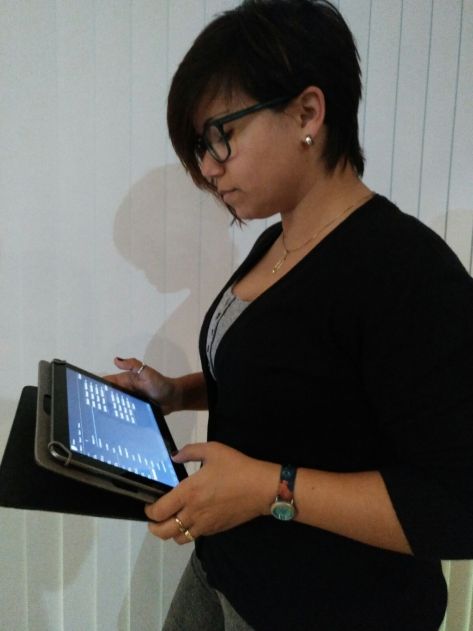NewsNext Previous
A new app for Android that lets to evaluate the museums reception wins a PIONER Prize
f theIt is about a tool that makes easier to collect more accurate data than the provided by the traditional surveys
Gemma Sebares is the creator, author of the doctoral thesis that promoted the design of this new technology
As a case of empirical study was took the socialization of the Atapuerca archeological sites, though the Museo de la Evolución Humana de Burgos
Gemma Sebares has received a PIONER Prize (Generalitat de Catalunya) as an author of a doctoral thesis that has let to design an app for Android that makes it easier to obtain more accurate data when is evaluated the reception of museum spaces from visitors. The author defended such thesis in December of 2015 in the Institut Català de Paleocologia Humana i Evolució Social (IPHES) and now has merited the award “for the contribution that makes the application of new technologies in a little transformed area”, according the jury resolution.
The award ceremony has taken place today in an event celebrated in the office of the CERCA Institution (Centres de Recerca de Catalunya, in Barcelona), entity that call them with the purpose to distinguish the researchers that newly elaborated a doctoral thesis and have obtained results clearly oriented to be used commercially. This year the prize has been of 1000 euros and a certificate.
The Gemma Sebares thesis is called “Evaluation of the process of socialization of the archeological field of the Sierra de Atapuerca to the Museo de la Evolución Humana in Burgos”, that has been taken as a case of empirical study. “This has been possible thanks to the design of a new method of data recollection and analysis, to make possible to extract an objective results, unleashing the evaluation from the classical surveys, completely subjective”, Gemma says. This method, in addition, is completely suitable in any other museographic space.
Sebares has analyzed, for example, if the museum solutions used in MEH are effective and suitable for any type of public, if in a museographic and didactic level has the necessary importance in the used resources, and if museology and museography are used correctly, how the museum fatigue affects in the visitors, has determined the attention and attraction levels and has reached a registry system and empiric analysis suitable in any other museum.
The data collection method it was made according to an app designed by herself and it was developed it by a computer programmer (Daniel Alcaraz Perelló). It has been conceived for Android system to be used in a tablet and is directly linked to a data base. The app Cronos.apk has been registered in i-DEPOT, intellectual property office of BENELUX, with validity in any country of the European Union.

At a time, the doctoral thesis has let to determine the socializing effectivity grade of the Museo de la Evolución Humana de Burgos (inaugurated on July of 2010) based on the visitor behavior, linking it to assembly of the museum analysis and information about the public’s profile.
With the use of the observational method it has been calculated the time that dedicates, or not, every visitor on looking to the different museographic resources of the museum. It has been determined the attracting power, the holding power, the interest level, the diligent visitors, the transition time, and the museum fatigue: all of this considering all the different sociodemographic groups, with the intention to catch the eventual problems in levels of every museum space or at the level of concrete museographic resources, and to improve, in that way, the socialization degree of the museum.
Among the major conclusions, it has been possible to establish the socialization capacity of the MEH. Seeing in result that the floor that works best is the first that is visited, the intended to the Sierra of Atapuerca archeological fields, with original fossils, one of the biggest claims of the museum, and that ends rounding the visit in all the Sierra de Atapuerca complex (museum, archeological fields, workshops…).
Futhermore, it has been possible to detect the “weak points” of the musrography whom a lot of the founded problems could be solved easily and improve, that way, the socialization of the museum.
The levels of attention, attraction, interest, thoroughness, transition and tiredness change considerably depending the analyzed sociodemographic group, but there are some museographic resources suitable for every one of the groups, and this encourage the socialization of the all of them.
At a methodological design level created for this research, is required to point that the app as well as the analysis and study method are completely appropriate in any other museum.
Profile
Gemma Sebares i Valle, raised in El Vendrell and born on Valencia in 1984, is graduate in History (Universitat Rovira i Virgili de Tarragona, URV), Master’s Degree in Quaternary Archaeology and Human Evolution (URV) and doctor in Quaternary and Prehistory (URV).
She began her formation in archeology since the first year of college, and clear for the beginning she participated with IPHES team in some archeological projects.
Eventually, as for the realization of the master, she began to specialize in the socialization of the heritage, especially the one related to the human evolution and prehistory.
Now she works as an associated professor in the Universitat de Barcelona, in the Didàctica de les Ciències Socials department, is member if the research group DEDPATRI (UB) and also Guia de Catalunya, exercising especially in the Tarragona province.


